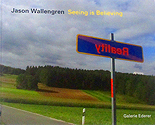
Seeing is Believing
Catalog, Galerie Ederer, November 2010, Nurnberg, Germany
To order a catalog, click here.
JW
by Cristobal Lehyt
Attempting to relate to place is to try to show, describe, narrate, and critique… to talk about oneself in
opposition and in relation to something that is always receding. Jason Wallengren’s work is about
this dynamic - to see a place and to imagine what it is and to then transform it.
His drawings appear to be about a solitary experience as he and later the viewer, re-imagine these interstitial spaces. The waiting areas and the non-descript passages described in these works, are considered seemingly empty. He draws the objects and spaces that maybe one sees through the corner of our eyes. There is agency in trying to depict these spaces, the wish to understand what they could mean, but most of all how they affect us.
Contrasting to this permeable representation are his road signs that point out ideas in the public space. To write loaded messages as signs is to personalize our surroundings and our potential connection to places and ideas that are not necessarily so immediate. These signs force us to stop and look and think. It must be strange to be forced to do that. First to welcome the proposition and then to feel literally directed by it, “Why must I think or look what you want me to?” Does it help me in any way? It is the altered experience of the visitor to a foreign place, or of the person that knows the place and is forced to think of it differently.
To be a tourist and be confronted by a dramatic event is not so far removed from being told the space one inhabits needs to be re-read. In the case of the Tourist Posters the events seem to be the point, they seem to tell the viewer the meaning is tied to them, but I wonder, since if one believes all of Jason’s work is about encounters, the most undetermined relation is the one that holds ones thoughts; the scenes already have observers, small and apparently distracting, which of course they are not. Their relationship to the event is ours, an alienated and caricaturized image of ourselves, of the maker and of the viewer. It’s a representation of alienation. A somehow passive and disturbing misencounter.
The Bild Perfect works, have the disturbing movement of an old discarded image. What looks to
be European sites re-imagined by an American. It shifts slowly like the eyes on the portrait paintings
in old movies, at first ominous only later to be somewhat comical and absurd. Because the place is
revolving, it is not to be placed or made foreign and uncanny.
The work that contrasts greatly with this alienation are the coffee sculpture objects. They are welcoming and playful landscapes of ridiculous scale. To project oneself onto these mountains of spent fuel is to feel protected. The material makes us think about feeling good and the landscape reminds us of infantile projection. Yet as in all of Jason’s work it is a strategy of how we can see ourselves looking at this landscape, this place.
Back to Links page